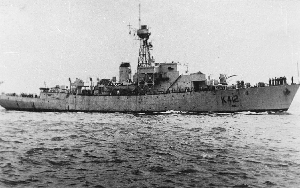
HMS Bamborough Castle was one of 44 Castle-class corvettes built for the Royal Navy during World War II. Completed in mid-1944 she sank the U-boat U-387 on 9 December. Aside from a brief period assigned to the Fishery Protection Squadron in 1946, the rest of her career was spent as part of the fleet reserve until she was scrapped in May 1959.

HMS Denbigh Castle (K696) was one of 44 Castle-class corvettes built for the Royal Navy during World War II. The ship was completed at the end of 1944 and was assigned to the 7th Escort Group at the beginning of 1945. While escorting her first and only Arctic convoy to Russia, she claimed to have shot down a German torpedo bomber. Denbigh Castle was torpedoed in early 1945 by the German submarine U-992, with the loss of 11 men, near the Soviet coast. The ship was beached in an effort to save her, but she was pulled off by the ebbing tide and capsized. Her wreck was declared a total loss.
HMS Allington Castle was one of 44 Castle-class corvette built for the Royal Navy during the Second World War. She was named after Allington Castle in Kent. Completed in 1944, she served as a convoy escort during the war and on fishery patrol duties in 1945–1947, being sold for scrap in 1958.
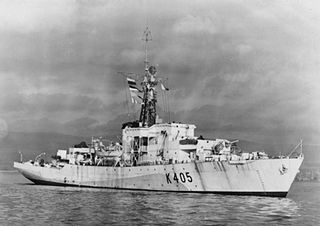
HMS Alnwick Castle was one of 44 Castle-class corvettes built for the Royal Navy during the Second World War. She was named after Alnwick Castle in Northumberland. Completed in late 1944, the ship served as a convoy escort until the end of the war, helping to sink one German submarine. The corvette was placed in reserve after the war and was sold for scrap in 1958.

HMS Flint Castle (K383) was one of 44 Castle-class corvettes built for the Royal Navy during World War II. Completed at the end of 1943, the ship ran aground while training in January 1944. After repairs were completed the following month, she was briefly assigned to the 39th Escort Group for convoy escort duties in the Atlantic Ocean. Flint Castle was transferred to Escort Group B2 in March and screened convoys to and from Gibraltar until September. That month, she joined Escort Group B3 to escort convoys between Canada and Britain and continued to do so until the end of the war in May 1945. The ship then became an anti-submarine training ship in Rosyth and Campbeltown, Scotland, before moving to Portland at the beginning of 1947. Flint Castle remained there until she was taken out of service in March 1956 and broken up beginning in July 1958.
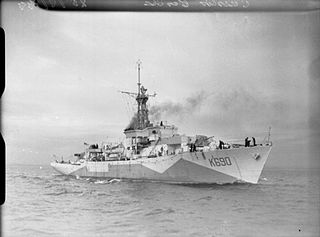
HMS Caister Castle was one of 44 Castle-class corvettes built for the Royal Navy during World War II.
HMS Carisbrooke Castle (K379) was one of 44 Castle-class corvettes built for the Royal Navy during World War II.

HMS Hurst Castle (K416) was one of 44 Castle-class corvettes built for the Royal Navy during World War II. Completed in June 1944, she began escorting convoys in August and was sunk by a German U-boat the following month.
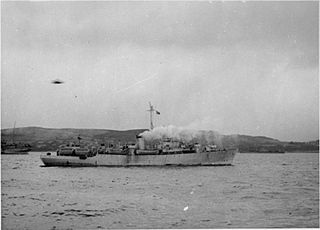
SS Empire Rest was a convoy rescue ship built for the Royal Navy during World War II, originally laid down as the Castle-class corvette Rayleigh Castle. Post-war she served as a transport ship until 1948, was sold in 1951, and scrapped in 1952.

HMS Brilliant was a B-class destroyer built for the Royal Navy (RN) around 1930. Initially assigned to the Mediterranean Fleet, she was transferred to the Home Fleet in 1936. The ship then patrolled Spanish waters enforcing the arms blockade during the first year of the Spanish Civil War of 1936–39. She spent most of World War II on convoy escort duties in the English Channel, and the North Atlantic, based at Dover, Gibraltar, and Freetown, Sierra Leone. During the war, Brilliant never destroyed a submarine, but did sink a Vichy French minesweeper during Operation Torch. She also intercepted two German supply ships and rescued survivors of two troopships that had been torpedoed by submarines. The ship became a target ship at the end of the war and was scrapped in 1948.

HMS Highlander was an H-class destroyer that had originally been ordered by the Brazilian Navy with the name Jaguaribe in the late 1930s, but was bought by the Royal Navy after the beginning of World War II in September 1939 and later renamed. When completed in March 1940, she was assigned to the 9th Destroyer Flotilla of the Home Fleet. The ship was assigned to convoy escort duties in June with the Western Approaches Command, sinking one German submarine in October. Highlander was transferred to Freetown, Sierra Leone, in mid-1941 to escort convoys off West Africa, but returned to the United Kingdom in August. She became flotilla leader of Escort Group B-4 of the Mid-Ocean Escort Force in early 1942 and continued to escort convoys in the North Atlantic for the rest of the war. The ship became a target ship after the war ended and was sold for scrap in mid-1946.
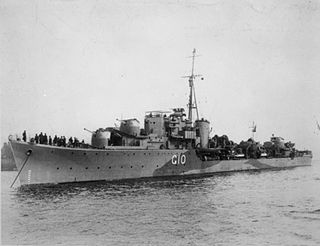
HMS Pathfinder was a P-class destroyer built for the Royal Navy during the Second World War. She was damaged while serving in the Far East, and was scrapped after the end of the war.
HMS Dumbarton Castle (K388) was one of 44 Castle-class corvettes built for the Royal Navy during World War II. She saw action in the Battle of the Atlantic during the war.

HMS Witherington was an Admiralty modified W-class destroyer built for the Royal Navy. She was one of four destroyers ordered in April 1918 from James Samuel White & Co Ltd. under the 14th Order for Destroyers of the Emergency War Program of 1917–18. She was the first Royal Navy ship to carry this name.

Empire Lifeguard (K443) was a convoy rescue ship of the Second World War. Initially built as HMS Maiden Castle - one of 44 Castle-class corvette built for the Royal Navy - she was completed in 1944 as a convoy rescue ship to pick up survivors from attacks on the convoys. Operated for the Ministry of War Transport (MoWT) she served in this role with convoys during the war. Post war she was operated as a transport in the Mediterranean. She was damaged by a terrorist attack and sunk in 1947 but repaired and ultimately sold for scrap in 1955.

HMS Shrewsbury Castle was one of 44 Castle-class corvette built for the Royal Navy during the Second World War. She was named after Shrewsbury Castle in Shrewsbury. Completed in 1944, she was loaned to the Royal Norwegian Navy as a convoy escort during the war, renamed HNoMS Tunsberg Castle and was sunk by a mine in December 1944.

HMS Morpeth Castle was one of 44 Castle-class corvette built for the Royal Navy during the Second World War. She was named after Morpeth Castle in Morpeth. Completed in 1943, she was used as a convoy escort during the war and was scrapped in August 1960.
HMS Tintagel Castle was one of 44 Castle-class corvette built for the Royal Navy during the Second World War. She was named after Tintagel Castle in Tintagel. Completed in 1943, she was used as a convoy escort during the war and was scrapped in August 1960.
HMS Pink was a Flower-class corvette that served in the Royal Navy. She was built by Henry Robb in Leith in 1941 and named after the flower nicknamed garden pink. She was commissioned in 1942 and scrapped in 1947.
HMS Fleur de Lys was a Flower-class corvette that served in the Royal Navy and was built by Smith's Dock Company in 1940. She was named after Fleur de Lys. Commissioned in 1940, rammed and sunk by U-206 on 14 October 1941. Her name was originally La Dieppoise and built for the French Navy but was later changed.













